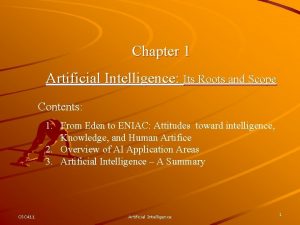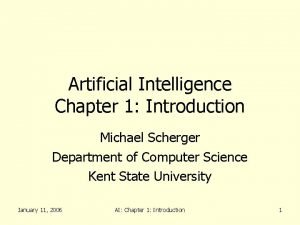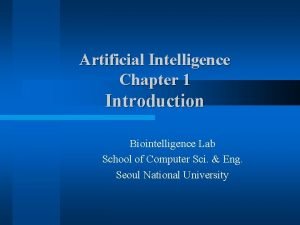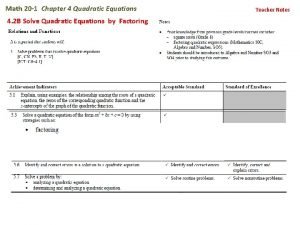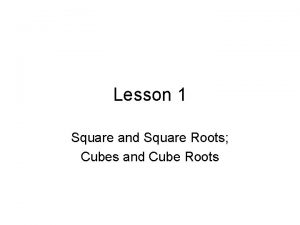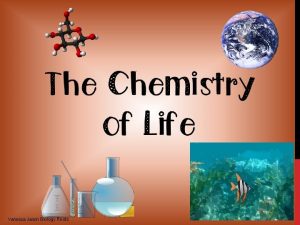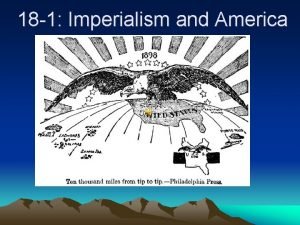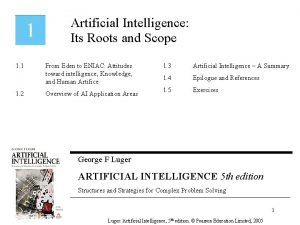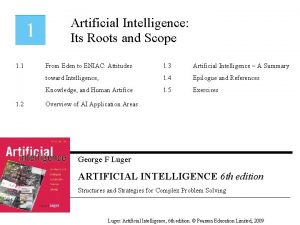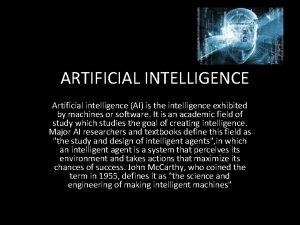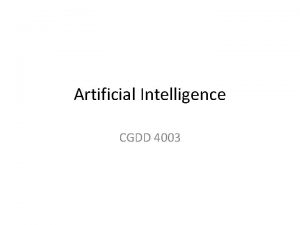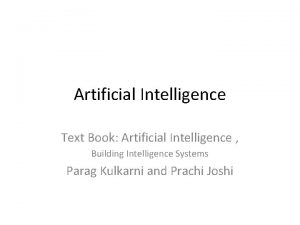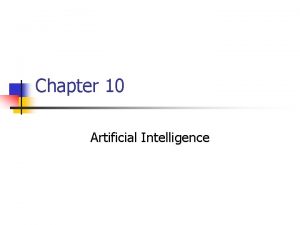Chapter 1 Artificial Intelligence Its Roots and Scope





















- Slides: 21

Chapter 1 Artificial Intelligence: Its Roots and Scope Contents: 1. From Eden to ENIAC: Attitudes toward intelligence, Knowledge, and Human Artifice 2. Overview of AI Application Areas 3. Artificial Intelligence – A Summary CSC 411 Artificial Intelligence 1

An Attempted Definition AI – the branch of computer science that is concerned with the automation of intelligent behavior – – Sound theoretical and applied principles Data structures for knowledge representation Algorithms of applying knowledge Languages for algorithm implementation Problem – What is Intelligence? This course discusses – The collection of problems and methodologies studied by AI researchers CSC 411 Artificial Intelligence 2

Brief Early History of AI Aristotle – 2000 years ago – – – The nature of world Logics Modus ponens and reasoning system Bacon – 1620 s – Search – Induction Calculating machines – – Ancient Chinese abacus (4000 years ago) John Napier – multiplication and exponents (1614) Pascal – Pascaline (1642, 1670) Leibniz – Lebniz Wheel (1694) – – – Thought and mind Separate mind from physical world Mental process Descrates (1680) CSC 411 Artificial Intelligence 3

Modern History Formal logic – Leibniz – Boole – Godel – Turing – Frege – first-order predicate calculus Graph theory – Euler State space search CSC 411 Artificial Intelligence 4

The Turing Test The interrogator • cannot see and speak to either • does not know which is actually machine • May communicate with them solely by textual device If the interrogator cannot distinguish the machine from the human, then the machine may be assumed to be intelligent. CSC 411 Artificial Intelligence 5

Models of Intelligence Logic Models – – Formal logic Probability logic Fuzzy logic Non-monotonic logic Biological Models – – – Connectionist model Genetic algorithms Evolution Social Models – Network models – Behaviors Agents -- Combination CSC 411 Artificial Intelligence 6

Agents Theories Intelligence is reflected by a collective behaviors of large numbers of very simple interacting, semiautonomous individuals – agents Various agents – – – Rote agents Coordination agents Search agents Learning agents Decision agents Agents design – Structure for information representation – Search strategies – Architecture for supporting the interaction of agents CSC 411 Artificial Intelligence 7

AI Research and Application Areas Game Playing Automated Reasoning and Theorem Proving Expert Systems Natural Language Understanding and Semantic Modelling Human Performance Planning and Robotics Languages and Environments for AI Machine Learning Alternative Representations: Neural Nets and Genetic Algorithms AI and Philosophy CSC 411 Artificial Intelligence 8

Important Features of Artificial Intelligence 1. The use of computers to do reasoning, pattern recognition, learning, or some other form of inference. 2. A focus on problems that do not respond to algorithmic solutions. This underlies the reliance on heuristic search as an AI problem-solving technique. 3. A concern with problem-solving using inexact, missing, or poorly defined information and the use of representational formalisms that enable the programmer to compensate for these problems. 4. Reasoning about the significant qualitative features of a situation. CSC 411 Artificial Intelligence Luger: Artificial Intelligence, 5 th 9 edition. © Pearson Education Limited, 2005

Important Features of Artificial Intelligence (Cont. ) 5. An attempt to deal with issues of semantic meaning as well as syntactic form. 6. Answers that are neither exact nor optimal, but are in some sense “sufficient”. This is a result of the essential reliance on heuristic problem-solving methods in situations where optimal or exact results are either too expensive or not possible. 7. The use of large amounts of domain-specific knowledge in solving problems. This is the basis of expert systems. 8. The use of meta-level knowledge to effect more sophisticated control of problem-solving strategies. Although this is a very difficult problem, addressed in relatively few current systems, it is emerging as an essential are of research. CSC 411 Artificial Intelligence 10

Part II: Artificial Intelligence as Representation and Search CSC 411 Artificial Intelligence 11

A proposal for the Dartmouth summer research project on Artificial Intelligence (url IIa). We propose that a 2 month, 10 man [sic] study of artificial intelligence be carried out during the summer of 1956 at Dartmouth College in Hanover, New Hampshire. The study is to proceed on the basis of the conjecture that every aspect of learning or any other feature of intelligence can in principle be so precisely described that a machine can be made to simulate it. An attempt will be made to find how to make machines use language, form abstractions and concepts, solve kinds of problems now reserved for humans, and improve themselves. We think that a significant advance can be made in one or more of these problems if a carefully selected group of scientists work on it together for a summer. J. Mc. CARTHY, Dartmouth College M. L. MINSKY, Harvard University N. ROCHESTER, I. B. M Corporation C. E. SHANNON, Bell Telephone Laboratories August 31, 1955 CSC 411 Artificial Intelligence 12

Main topics for discussion at the AI conference, Dartmouth College 1956 (url IIa). 1. Automatic Computers 2. How Can a Computer be Programmed to Use a Language 3. Neuron Nets 4. Theory of the Size of a Calculation 5. Self-Improvement (Machine Learning) 6. Abstractions 7. Randomness and Creativity CSC 411 Artificial Intelligence 13

Representation Systems What is it? – Capture the essential features of a problem domain and make that information accessible to a problem-solving procedure Measures – Abstraction – how to manage complexity – Expressiveness – what can be represented – Efficiency – how is it used to solve problems Trade-off between efficiency and expressiveness CSC 411 Artificial Intelligence 14

Representation of Different representations of the real number π. CSC 411 Artificial Intelligence 15

Image Representation • Array representation – 2 D • Image representation -- Digitized image of chromosomes in metaphase. CSC 411 Artificial Intelligence 16

Block World Representation A blocks world Logical Clauses describing some important properties and relationships General rule CSC 411 Artificial Intelligence 17

Bluebird Representations Logical predicates representing a simple description of a bluebird. Semantic network description of a bluebird. CSC 411 Artificial Intelligence 18

State Space Search State space – State – any current representation of a problem – State space All possible state of the problem Start states – the initial state of the problem Target states – the final states of the problem that has been solved – State space graph Nodes – possible states Links – actions that change the problem from one state to another State space search – Find a path from an initial state to a target state in the state space – Various search strategies Exhaustive search – guarantee that the path will be found if it exists – Depth-first – Breath-first Best-first search – heuristics CSC 411 Artificial Intelligence 19

Tic-tac-toe State Space Portion of the state space for tic-tac-toe. CSC 411 Artificial Intelligence 20

Auto Diagnosis State Space State space description of the automotive diagnosis problem. CSC 411 Artificial Intelligence 21
 Lesson 3 existence and uniqueness
Lesson 3 existence and uniqueness Searching for solutions in artificial intelligence
Searching for solutions in artificial intelligence Artificial intelligence chapter 1
Artificial intelligence chapter 1 Artificial intelligence chapter 1
Artificial intelligence chapter 1 Artificial intelligence chapter 1
Artificial intelligence chapter 1 Square root 1 to 100
Square root 1 to 100 Quadratic equation with roots
Quadratic equation with roots Opposite of squaring
Opposite of squaring Math for artificial intelligence
Math for artificial intelligence Informed search and uninformed search
Informed search and uninformed search Pxdes
Pxdes Vanessa jason biology roots answer key
Vanessa jason biology roots answer key The roots of american imperialism economic roots
The roots of american imperialism economic roots Mycin advantages and disadvantages
Mycin advantages and disadvantages State space search in ai
State space search in ai Searching for solutions in artificial intelligence
Searching for solutions in artificial intelligence 15-780 graduate artificial intelligence
15-780 graduate artificial intelligence Knowledge manipulation in ai
Knowledge manipulation in ai What is meta knowledge in artificial intelligence
What is meta knowledge in artificial intelligence Starts new page numbered sequentially
Starts new page numbered sequentially Kecerdasan kepemimpinan
Kecerdasan kepemimpinan Uas kecerdasan buatan
Uas kecerdasan buatan


